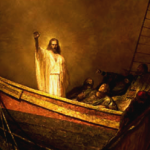by Fr. Patrick Henry Reardon
 According to the indications in the gospels, a bit over two years elapsed between the event at Cana and the final events of his life. This estimate is based on the Gospel of John, which mentions three different observances of the Passover, one just after the marriage at Cana (John 2:13), a second around the time of the multiplication of the loaves (6:4), and a third at the end of Jesus’ life (11:55).
According to the indications in the gospels, a bit over two years elapsed between the event at Cana and the final events of his life. This estimate is based on the Gospel of John, which mentions three different observances of the Passover, one just after the marriage at Cana (John 2:13), a second around the time of the multiplication of the loaves (6:4), and a third at the end of Jesus’ life (11:55).
There is no serious reason, I believe, to challenge that calculation.
Within that two-year period, however, the chronology of the events themselves is less easy to follow. Modest estimates can be made, of course. For example, because the multiplication of the loaves and Jesus’ walking on water took place near the second Passover of his ministry (John 6:4)—and Mark 6 records these same events—it may be legitimate to conclude that other things recorded in Mark 6 also happened near the same time. These include Jesus’ rejection at Nazareth and the missionary trip of the apostles (Mark 6:1-13). It may be inferred, in other words, that Jesus was rejected at Nazareth and sent out the missionary group about one year before his death.
No matter how reasonable that conclusion seems, nonetheless, the case for it is far from certain. Mark’s ordering of the events in Jesus’ life appears to be determined—in the main—not by the restraints of historical chronology, but by a symmetric literary structure and the author’s theological concerns.
By the time the four gospels were composed, moreover, it is safe to say that probably nobody was certain of the actual sequence of all the events in Jesus’ life. It was not thought to be important. Other considerations, consequently, determined the order in which these stories were handed down in the Church’s catechesis (based on the apostles’ preaching) and later recorded (in the four gospels).
Although the gospels are placed in the New Testament in front of the epistles, the actual historical order of the works was entirely reversed. That is to say, when Paul wrote his letters between roughly A. D. 49 and 63, not a single one of the gospels had been composed. In comparison with the rest of the New Testament, the gospels were the “late” books. We have fairly firm historical testimony that the earliest of the gospels, Mark, was not composed until after the fire at Rome in the summer of A. D. 64.
The relative “lateness” of the gospels hardly means, of course, that their narrative material was unknown to the early Christians. No one will seriously contend that between A. D. 33 (or so) and 64 nobody knew what Jesus did and taught!
In fact, behind each of the gospels, there was a full generation and more of Christian preaching and catechesis. Very little was written down in the gospels that had not been preached and taught. For instance, from earliest times we have widespread testimony that Mark’s Gospel was based on his immediate and first-hand memory of Peter’s preaching in Rome.
Now one thing preachers and catechists do is arrange their material according to preferred and chosen themes. Only rarely, and by accident, has a preacher or catechist been much concerned with points of chronology.
Consequently, if the gospel stories were preserved in patterns determined by pedagogy and rhetoric, we should expect the gospel sequences to be thematic, not chronological. And this is, in fact, what we find.
We may have an instance of this phenomenon in the stories of the storm at sea and the Gadarene demoniac. The storm scene ends with the question, “Who can this be?” This question is answered by the demoniac in the next story:
“What have I to do with You, Jesus, Son of the Most High God?” (Mark 4:41; 5:6).
Does the juxtaposition of these two scenes—the storm and the demoniac—represent a preaching motif of early Christian preaching, a remnant of pre-baptismal catechesis, or does it simply mean the two events actually followed one another in sequence? It is difficult to say, but is it unnecessary to decide? The two stories clearly belong together, which is doubtless the reason all three Synoptics put them together. Christian readers have long read them together, and over the centuries Christian preachers have, with marvelous frequency, made both stories components in the same sermon.
